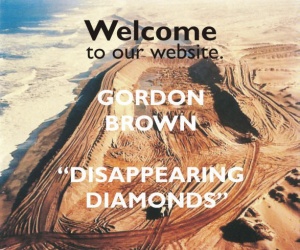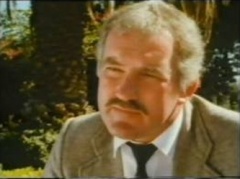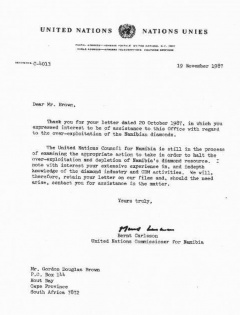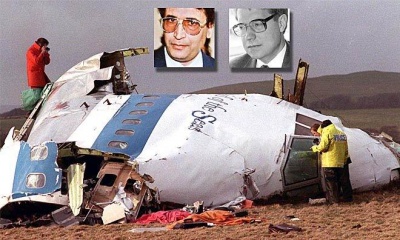Gordon Douglas Brown

Gordon Douglas Brown (died 21 February 2014)[1] co-authored a pamphlet entitled "Gordon Brown is Innocent" with Laurie Flynn, after they investigated De Beers' mining practices for Granada Television’s World in Action documentary film "The Case of the Disappearing Diamonds" which was broadcast on 28 September 1987:[2]
- "Since its foundation just over a century ago De Beers has become one of the most controversial business enterprises in the world. Its business practices in wartime, its use of migrant labour and discriminatory labour practices, its dalliance with apartheid, its clashes with American competition authorities and the United Nations have all been the subject of high controversy. In 2004 De Beers was given a formal criminal conviction in the United States for conspiracy to violate competition law and fined $10 million. In November 2005 the group agreed to pay $295 million to settle price fixing and restraint of trade law suits brought in law courts in Arizona, San Francisco and Trenton, New Jersey.
- "Whatever its problems in America, De Beers' fortunes are closely tied in with the highly political economy of diamonds in sub-Saharan Africa and with Botswana, South Africa and Namibia in particular. This pamphlet focuses on extraordinary events in the last of these countries. Occupied illegally for decades by apartheid South Africa and with the world’s finest deposits of gem diamonds, Namibia was the building block with which De Beers and its sister company Anglo American assembled the greatest treasure trove of assets in the world of mining. According to statements in the press and on their website Anglo and De Beers are very keen to distance themselves from a troubled past and will henceforth ‘always listen first and then act with openness, honesty and integrity so that our relationships flourish.’ If Gordon Brown’s experience is anything to go by the Anglo/De Beers commitment to integrity and law abiding behaviour has some considerable way to go. The way he has been treated is unconscionable and he calls out for justice and an end to the persistent violations of his human rights."
Contents
Evidence against De Beers

Max du Preez, one of Southern Africa’s most admired reporters, has worked for the Financial Mail, the Sunday Times and SABC. He was also the founder of Die Vrye Weekblad, closed down by the apartheid government for its fearless reporting of business and political scandals. This is how Max du Preez described the importance of Gordon Brown's evidence against De Beers:
- "Early in 1984, the issue of CDM's 'overmining' of the Oranjemund mine was again mentioned at hearings into government corruption in Namibia. This time I got hold of a solid source, Gordon Brown, a senior man at De Beers who had serious moral qualms about what they were doing to the mine. He started briefing me on the technical issues and gave me a number of documents with explosive content.
- "An understanding of CDM’s unique position in Namibia is important in order to grasp the overmining story. CDM mined the world’s richest diamond fields in terms of an agreement with the South African administration in Namibia which was bound to act in compliance with a League of Nations mandate to protect the interests of the people of the territory.
- "The Halbscheid agreement stated: 'CDM when working an area pegged under this, shall conduct operatiaons as thoroughly and economically as it does on its other mining fields and shall carry on mining satisfactorily to the Administrator and not with a view to exhausting the superficial and more valuable deposits to the detriment of the low grade deposits.'
- "The idea was that the diamond field should provide Namibia with a source of revenue and employment for as long as possible. CDM, I wrote in my first piece in the Financial Mail, was in breach of the Halbscheid agreement because it was in mining-speak 'picking the eyes out of the mine' preferentially mining the richer deposits at the expense of the mine’s future profits.
- "I had CDM’s own documents to back this up. The smoking gun was a document called 'A life of Mine Review', drawn up by the then manager at Oranjemund Jack Forster in September 1981. Foster used these words: 'To me this is best described as a power dive and unless we have a conscious change in strategy effective some time in the future, we will power the mine into the ground and we will be unable to conduct the reclamation and cleaning operation which could extend the life of the mine by three or four years.'
- "The morning of the publication of my story, Mulholland (the editor) walked to my desk, and slammed the magazine down and asked: 'What the hell do you think you are doing?' He said I knew nothing about mining: 'It is clearly news to you that mining companies are in the business for a profit.' I tried to explain about the 1923 agreement but he didn’t want to discuss the merits. He warned me to drop the story.
- "I checked with Gordon Brown, who said my story was spot on. I vowed not to leave it there. A few weeks later, when Mulholland was out of town I wrote a follow-up story sticking to my line. Mulholland was livid. He accused me of damaging the reputation of the Financial Mail. I told Mulholland that I thought it was my ethical duty to follow through with the story.
- "CDM’s next move was to invite me to a briefing where they would explain everything at 44 Main Street, the Anglo head office in Johannesburg. We met in their impressive boardroom. Mulholland introduced me. As I heard the names and titles, it dawned on me that this was the entire upper hierarchy of the De Beers empire, including the chairman, the Oranjemund mine manager and the top man of the Central Selling Organisation in London.
- "I wanted to explain the documents I had in my possession. Clearly annoyed, they explained some of the technical stuff and at more than one point they said that the details would be difficult for a lay-person to comprehend. But Gordon had briefed me well, and I did follow the arguments. I started putting more documents on the table to counter what they were saying, especially the mine manager’s statement that CDM was ‘powering the mine into the ground’. Mulholland silenced me, thanked the De Beers bosses profusely and apologised for my stubbornness. I was ushered out. This showdown meant the end of my career at the Financial Mail.
- "But it wasn’t the end of the CDM story; it was the beginning although the FM would no longer take part in the expose. The FM’s opposition magazine, Finance Week had by now taken up the story as had the Namibian press.
- "Mr Justice Pieter Thirion soon expanded his inquiry into mal-administration in Namibia to include an investigation into the Diamond Industry and the workings of the Diamond Board. Gordon Brown came out of the shadows and gave devastating evidence before Thirion. The Thirion report published in March 1986, vindicated every word I had written, and more. The documents Brown had given me were extensively quoted in the report – and they were given Brown’s interpretation which I in turn used in my reports and in the sham briefing with CDM. Justice Thirion found that CDM had breached the Halbscheid agreement by excessively depleting the Oranjemund diamonds for at least twenty years. The excessive depletion of the deposit was preferential depletion of the more valuable deposits to the detriment of the low grade deposits. The probabilities are that the effect of the excessive depletion of the deposit will be to shorten the life of the mine and to detrimentally affect its profitability towards the end of its life.[3]
- "The next year Gordon Brown was the star of a powerful Granada documentary shown on ITV, titled The Case of the Disappearing Diamonds. It found that De Beers had secretly stripped Namibia of 3 billion rands worth of diamonds through overmining. Brown went on to appear in the BBC documentary 'The Diamond Empire', and became a central figure in the authoritative book by Laurie Flynn on violations by Southern African mining companies called 'Studded with diamonds and paved with gold'. But Brown was to pay a heavy price for blowing the whistle on De Beers: first with the reports he gave me; then by giving evidence to Thirion; and finally by appearing in the documentaries.
- "An elaborate trap was set for him. He was asked by an acquaintance, a dealer in rough diamonds, to evaluate a parcel of diamonds. Gordon Brown was given an assurance that these were legal diamonds from Angola, and the necessary permits had been issued and the legal requirements complied with. The Diamond and Gold Branch of the Namibian police then pounced and arrested him on an illicit diamond buying charge. He was found guilty in court and sent to jail. Brown claims he was denied the fundamental right to a fair trial. He says his conviction was based on the perjured testimony of a single witness, a De Beers employee. This witness subsequently confessed in an affadavit made to Namibian justice department officials.
- "Shortly after his incarceration, Gordon Brown was released on bail pending an appeal hearing. He tried his best to get the police and justice department to investigate prosecutorial irregularities and misconduct, but nobody would do anything. Brown says he then lost faith in the justice system in Namibia and decided to skip bail. He actually had to swim across the Orange River to his freedom in South Africa. He continued to work in the diamond industry in South Africa.
- "As long as De Beers appointees sit on government regulatory bodies and their security people hold top position in the Gold and Diamond Branch of the Namibian Police," Brown told me, "no serious critic of De Beers can survive criminal charges from the police or De Beers themselves, and you certainly cannot expect a fair trial on such charges.’
- "That’s what happens when you mess with Anglo American."[4]
The Case of the Disappearing Diamonds
- Full article: The Case of the Disappearing Diamonds
- Full article: The Case of the Disappearing Diamonds

In this 1987 documentary film, former CDM manager, Gordon Brown, stated that for 20 years De Beers had been extracting Namibian diamonds at Oranjemund:
- "Overmining took place on the upper terraces and the 'N' blocks [in the upper terraces, blocks K, L, and M were rich in diamonds and the richest of all were the 'N' blocks] which were the series of beaches situated furthest from the sea. That's where the richest blocks were in terms of grade and stone size. There was a central block between the two major beaches that was of lower grade. That was left behind - the company concentrated on taking out the ore reserves furthest from the sea. That's not good mining practice. Proper mining practice calls for the average ore reserve grade and average stone size. I would liken this to a nice big cream cake, with a sponge cake below. Normally you would take out a slice at a time, but in the case of overmining the cream is completely scraped off the top."
Letter to Bernt Carlsson
One month after "The Case of the Disappearing Diamonds" was broadcast on British television, former Consolidated Diamond Mines manager, Gordon Brown, who was interviewed in the film, wrote from Cape Town to Bernt Carlsson in New York offering his expert assistance in building the prosecution case against De Beers for overmining Namibia's diamond gemstones. In his letter, Brown had calculated the quantum and value of diamonds illegally removed from Namibia from 1967, when South-West Africa became the responsibility of the United Nations, until the territory was likely to become independent in 1989/90. By which time, De Beers/Anglo American and the Apartheid State would have illegally removed:
- 44 million Diamonds, weighing
- 33 million Carats, with an average diamond size of
- 0.75 Carats per Diamond.
Gordon Brown estimated the current value of those diamonds amounted to:

- £11.0 billion, ($18.7bn) being Revenue from Diamond Sales (Standard Selling Value)
- £ 3.3 billion, ($ 5.6bn) spent on Working Costs and Capital Expenditure, leaving
- £ 7.7 billion, ($13.1bn) of Working Profit, distributed as follows:
- £ 4.4 billion, ($ 7.5bn) as De Beers/Anglo American’s Profit Share, and
- £ 3.3 billion, ($ 5.6bn) as Apartheid State’s Profit Share through Taxes, Royalties, etc.
Bernt Carlsson replied by letter dated 19 November 1987 (referenced C-4013):
- Dear Mr Brown,
- Thank you for your letter dated 20 October 1987, in which you expressed interest to be of assistance to this Office with regard to the over-exploitation of the Namibian diamonds.
- The United Nations Council for Namibia is still in the process of examining the appropriate action to take in order to halt the over-exploitation and depletion of Namibia's diamond resource. I note with interest your extensive experience in and in-depth knowledge of the diamond industry and CDM activities. We will, therefore, retain your letter on our files and, should the need arise, contact you for assistance in the matter.
- Yours truly,
- Bernt Carlsson
- United Nations Commissioner for Namibia
"Lockerbie: A Prime Suspect"
On 28 January 2010, Gordon Brown published his theory entitled "Lockerbie: A Prime Suspect":
- With reference to the murder of United Nations Commissioner for Namibia, Bernt Carlsson, and 269 other innocent folk in the attack on Pan Am Flight 103 over Scotland in 1988, it would not be out of line to consider the De Beers/Anglo American Group a prime suspect as it had the Motive, Means and Opportunity to carry out such an attack.
- MOTIVE: With regards to motive, the Group had a pressing need:
- 1. to prevent an in-depth investigation of its decades-long illegal gem diamond mining operations in Namibia in breach of United Nations Decree No. 1 which Bernt Carlsson was about to conduct;
- 2. to prevent the United Nations Commissioner for Namibia from further uncovering and quantifying the secretive high-grading/overmining practice which the Group had embarked upon with the object of depleting Namibia’s more valuable gem diamond resources ahead of an internationally recognised independence settlement: an illegal practice which had been brought to public note through the findings of the Thirion Judicial Commission of Inquiry;
- 3. to hide from public scrutiny the human rights abuses and discriminatory employment practices the Group’s Namibian employees had been subjected to for more than 50 years;
- 4. to ward off a massive claim for damages the United Nations could legally have instituted against the Group on behalf of the people of Namibia;
- 5. to frustrate any action likely to threaten the Group’s dominant control of diamond mining in Namibia and prevent its lucrative concessions from being legally expropriated in the public interest and granted to a less controversial and more responsible mining company. This effectively would have ended the De Beers Diamond Cartel’s monopolistic control of the world diamond industry.
- MEANS: Through the Group’s established contacts and dealings with the CCB, CIA (through Maurice Tempelsman), BOSS and Executive Outcomes, the Group most certainly possessed the means to carry out such an attack. Breaking into Heathrow Airport’s luggage handling section would have posed little difficulty to any one of these organisations. There was money and expertise aplenty to carry out such an operation.
- OPPORTUNITY: There was more than adequate time to plan and execute this heinous criminal act as Bernt Carlsson’s movements and travel arrangements, dictated in part by De Beers in London, were known to the Group well in advance. It was the ideal crime as nobody would ever suspect Bernt Carlsson was the target and therefore no finger would ever point at De Beers/Anglo American. This cowardly attack was conveniently labelled the dastardly work of a terrorist organisation.[5]
"One Step at a Time"
On 30 January 2010, Secretary of the 'Justice for Megrahi' campaign, Robert Forrester (aka "Quincey Riddle"), responded with a critique headed "One Step at a Time":
- I must confess that, academically speaking, I lack what some seemingly do not: a doctorate in Double Think.
- With regard to the Carlsson angle specifically:
- A: Without doubt the RSA government of the day would have been more than happy to have him 'removed'.
- B: However, by blowing up a jumbo with 258 innocent bystanders on board in the process! To what end? To provide a cover and cast the blame on to a group of disaffected Arabs or Iranians?
- C: Surely Pretoria had plenty of alternatives that could have achieved the same goal without all the 'collateral' (I believe is the appropriately sanitised term to express mass murder these days).
- D: Let's not forget how much they had learnt from the results yielded via their investment in Project Coast.
- E: In other words: why not simply do a Georgi Markov number on him (Bernt Carlsson)?
- F: After all, the progress made in the realms of DNA sequencing and biotoxins through Coast would have been sufficiently well advanced at the time to make discovery almost impossible unless the pathologists knew exactly what they were looking for.
- Now then. I have an immense degree of respect for Tam Dalyell, however, when he refers to a Faustian pact whereby Washington subcontract the job to Pretoria, I am afraid I do not know in what context this statement was set. Was it, for example, one of: 'it is not beyond the bounds of credibility to imagine.......etc'? Or, was it an assertion? Mr Dalyell has also said, and here I paraphrase, that the only hope of discovering who committed the act (Lockerbie bombing) probably lies in one of the perpetrators believing sufficiently strongly in God that there is a deathbed confession. I, therefore, cannot believe that any reference to a Faustian pact on Tam Dalyell's part was anything other than a nodding acknowledgement of the theory.
- Nevertheless, on the grounds that it is not unknown for governments and their servants to indulge in apparently insane and overly complex subterfuge, where is the proof? The layman casting an eye over this can arrive at one of two equally valid conclusions:
- 1: The whole thing is so spectacularly convoluted as to render it credible on the grounds that it is precisely the type of machination that people dream up when they have something to hide.
- 2: The whole thing is so spectacularly convoluted as to render it incredible, particularly when we place its apparent sophistication beside the fact that Pik Botha was booked on to the same flight only for himself and his entourage to unbook themselves. But there again, some might argue that that slip up was a blind to make it look like RSA had no blood on its hands because they wouldn't have made such a stupid mistake, would they?
- How far then does this take Saul along his journey to Damascus? Precisely nowhere in my view. Don't get me wrong, I am a huge fan of crime fiction, and theories of this nature are most stimulating, but for me, until some tangible proof emerges, I am afraid they only serve as a form of intellectual exercise.
- Furthermore, my principal motivation in the Lockerbie issue is the travesty of justice that was Zeist. Whatever I may think about who dunnit (and I do have my thoughts, prosaic though they may be), I am not interested in apportioning blame at this stage. What I am very much interested in doing though is righting a wrong. One step at a time, my friends.
- Anyhow, just a couple of passing thoughts.
- Toodle pip for the moment,
- Robert Forrester ('Justice for Megrahi' campaign committee member).[6]
Correction by Gordon Brown
In Robert Forrester's 30 January 2010 comment on "The London Origin Theory", he mentions in point 2:
- "The whole thing is so spectacularly convoluted as to render it incredible, particularly when we place its apparent sophistication beside the fact that Pik Botha was booked on this same flight only for himself and his entourage to unbook themselves. But there again, some might argue that the slip was a blind to make it look like RSA had no blood on its hands because they wouldn't make such a stupid mistake, would they?"
- This 'fact' is incorrect. The person who made the bookings for the South African group made it originally on Pan Am Flight 101 departing London at 11:00am on 21 December 1988. It was never made on Pan Am 103 and consequently was never changed. He made the reservation on Pan Am 101 because it was the most convenient flight connecting with South African Airways Flight SA 234 arriving at Heathrow at 07:20am on 21 December 1988.
- One might also want to establish the whereabouts of CCB operative and explosives expert Nico Palm about that time. Palm was associated with a front company Geo International Trading for which, as an explosives expert, he conducted "... specific tasks during highly sensitive foreign operations" (Special Forces chief, Major-General 'Joep' Joubert). Palm was assigned to CCB operational Region 5 (International and Europe), which was led by Eeben Barlow.
- In 1999 Craig Williamson and seven former agents of the Civil Cooperation Bureau applied for amnesty to the South African Truth and Reconciliation Commission for the 1982 bombing of the ANC's offices in London. Speaking after the amnesty hearing, South African lawyer Anton Alberts said:
- "If you look at the Lockerbie disaster - this is very similar. I think Britain would like to see these guys are prosecuted in England even though they get amnesty here."[7]
Washington's Faustian Pact
On 12 November 2012, Barry Walker (aka 'baz') joined the Lockerbie debate:
- I think 'Quincey Riddle' got it wrong when he referred to Tam Dalyell's claim of a Faustian pact "whereby Washington subcontracted the job to Pretoria".
- What Patrick Haseldine claimed Dalyell said was that Washington entered into a Faustian pact tit-for-tat that one aircraft would be sacrificed for another. Whether this pact was overt or implied it seems to a quite reasonable explanation of a way out of the crisis caused by the Vincennes Incident. It is elementary International Relations theory (see Professor Spanier's wickedly titled "Games Nations Play" or check out the film and novel "Fail Safe".)[8]
